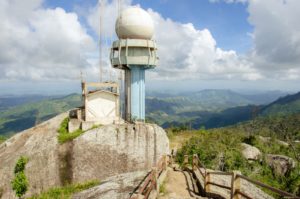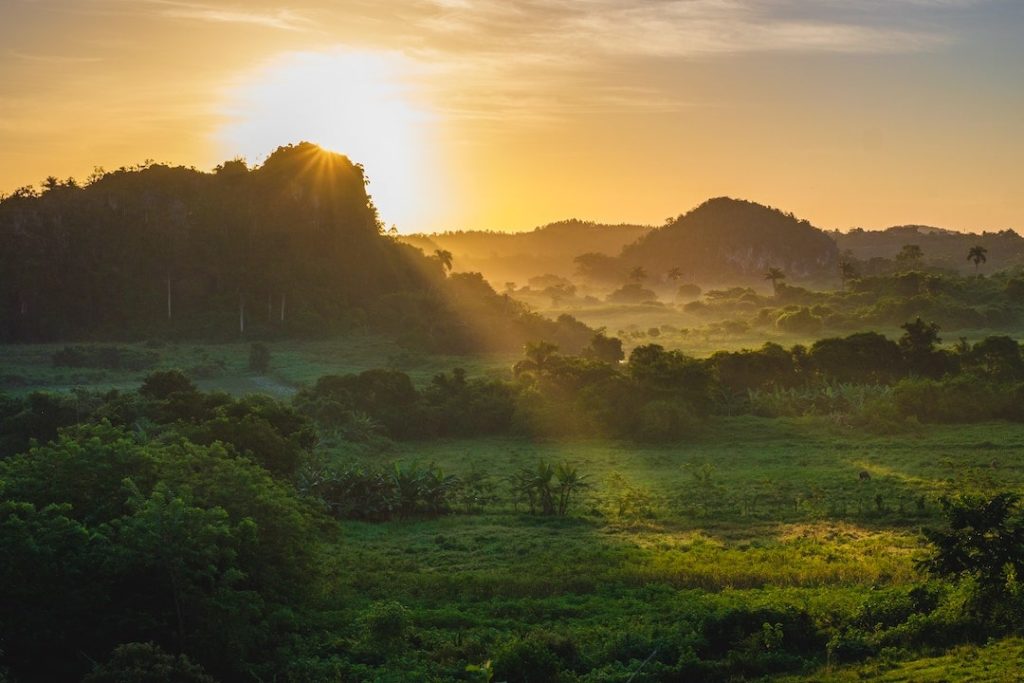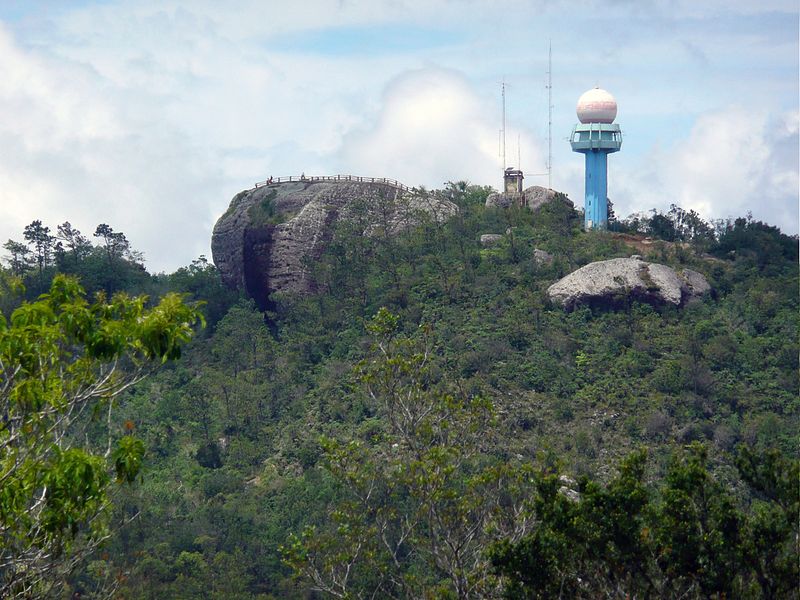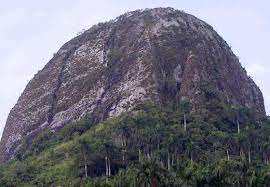LA GRAN PIEDRA (GREAT STONE), CUBA, LARGEST VOLCANIC STONE IN THE CARIBBEAN REGION. VIDEOS.
The Gran Piedra mountain in Cuba, formed most likely from a volcanic rupture, the “Gran Piedra” (the Grand Stone) is an enormous rock measuring 51 yards long and 25 to 30 yards wide. With a calculated weight of 63,000 tons, this boulder is situated on the summit of a mountain rising 1,225 meters above sea level. It is located in the province of Provincia de Santiago de Cuba, in the southeastern part of the country, 800 km southeast of Havana the country’s capital. 1,216 meters above sea level is located in Gran Piedra. Gran Piedra is part of the Cordillera de la Gran Piedra .
The land around Gran Piedra is mostly hilly, but to the west it is mountainous. Gran Piedra is the highest point in the area. There are about 427 people per square kilometer around Gran Piedra which is extremely populous. The area around Gran Piedra is almost forested. In the region around Gran Piedra, beaches, and resources are remarkably common.
 VIDEOS- THE GREAT STONE, CARIBBEAN LARGEST
VIDEOS- THE GREAT STONE, CARIBBEAN LARGEST
The legends of its origin include everything from it has formed with the impact of a meteorite that fell to the earth millions of years ago to what is believed more accurate versions that consider its birth due to the explosion of an underwater volcano.
This unique site is now registered as a national monument.
The gigantic stone mass was perhaps a witness to the volcanism of the Paleocene, just like all of the geology of the Sierra Maestra Mountains, where strata of this type of rock are presently composed of layers of volcanic lava. This mass is famous not only within the frontiers of the island but also all across the Caribbean since it is the largest such stone in the entire region.
It is a natural watchtower from where the whole mountain range of the Sierra Maestra can be observed; likewise, almost the entire southeastern coast can be seen from here. Locals swear that on a clear night one can even see the gleam of lights coming from the neighboring Republic of Haiti.
In its surroundings, one can enjoy unique flora consisting of 222 varieties of ferns, as well as a total of 352 types of orchids, eucalyptuses, maestrense pines, cubenses, cypresses, and a variety of fruit-bearing trees –among them peaches, as odd as that might seem.
The fauna of the Gran Piedra is also one of its strongest attractions. Around the great mass flutter carpenter birds, royal thrushes, cartacubas, sparrow hawks, torcazas and mays, all led by our national bird: the tocororo.
Only a half-mile away, one can find the area’s Botanical Garden, where species such as the bird of the paradise, dahlias, magnolias, and other flowers are raised in a singular manner as they take advantage of the microclimate that prevails in the area.
The constant fog and the ever-damp moss ground-coverings typically pervade the mystery and enigma of this setting, one whose geo-morphological, ecological, climatological, and topographical particularities lend it great importance for ecological tourism.
The highlight of the visit is the exciting adventure of climbing, wrapped in the dense fog, 452 steps up and accompanied by dense vegetation of ferns and other species that perfume the atmosphere.
LA GRAN PIEDRA, CUBA, LA MÁS GRANDE FORMACIÓN VOLCANICA DEL CARIBE. VIDEOS
La montaña Gran Piedra en Cuba, formada muy probablemente a partir de una ruptura volcánica, la “Gran Piedra” (la Gran Piedra) es una enorme roca que mide 51 yardas de largo y 25 a 30 yardas de ancho. Con un peso calculado de 63.000 toneladas, esta roca está situada en la cima de una montaña que se eleva a 1.225 metros sobre el nivel del mar. Se ubica en la provincia de Santiago de Cuba, en el sureste del país, 800 km al sureste de La Habana, la capital del país. A 1.216 metros sobre el nivel del mar se encuentra en Gran Piedra. Gran Piedra es parte de la Cordillera de la Gran Piedra.
La tierra alrededor de Gran Piedra es mayormente montañosa, pero al oeste es montañosa. Gran Piedra es el punto más alto de la zona. Hay alrededor de 427 personas por kilómetro cuadrado alrededor de Gran Piedra, que es extremadamente poblada. El área alrededor de Gran Piedra es casi boscosa. En la región alrededor de Gran Piedra, las playas y los recursos son muy comunes.
Las leyendas de su origen abarcan desde que se formó con el impacto de un meteorito que cayó a la tierra hace millones de años hasta lo que se cree versiones más precisas que consideran su nacimiento debido a la explosión de un volcán submarino.
Este sitio único ahora está registrado como monumento nacional.
La gigantesca masa de piedra fue quizás testigo del vulcanismo del Paleoceno, al igual que toda la geología de la Sierra Maestra, donde los estratos de este tipo de rocas están compuestos actualmente por capas de lava volcánica. Esta masa es famosa no solo dentro de las fronteras de la isla sino también en todo el Caribe, ya que es la piedra más grande de toda la región.
Es una atalaya natural desde donde se puede observar toda la sierra de la Sierra Maestra; Asimismo, desde aquí se puede ver casi toda la costa sureste. Los lugareños juran que en una noche despejada incluso se puede ver el brillo de las luces provenientes de la vecina República de Haití.
En sus alrededores se puede disfrutar de una flora única compuesta por 222 variedades de helechos, así como un total de 352 tipos de orquídeas, eucaliptos, pinos maestrense, cubenses, cipreses y variedad de árboles frutales, entre ellos melocotones, como por extraño que parezca.
La fauna de la Gran Piedra es también uno de sus mayores atractivos. Alrededor de la gran masa revolotean pájaros carpinteros, tordos reales, cartacubas, gavilán, torcazas y mays, todos liderados por nuestro ave nacional: el tocororo.
A tan solo un kilómetro de distancia se encuentra el Jardín Botánico de la zona, donde especies como el ave del paraíso, dalias, magnolias y otras flores se crían de manera singular aprovechando el microclima que impera en la zona. .
La niebla constante y las cubiertas de musgo siempre húmedo impregnan típicamente el misterio y el enigma de este entorno, cuyas particularidades geomorfológicas, ecológicas, climatológicas y topográficas le confieren una gran importancia para el turismo ecológico.
El punto culminante de la visita es la apasionante aventura de la escalada, envuelto en la densa niebla, 452 escalones y acompañado de una densa vegetación de helechos y otras especies que perfuman el ambiente.
Agencies/ Wiki/ Internet Photos/ EcuRed/ YouTube/ Arnoldo Varona/ TheCubanHistory.com
THE CUBAN HISTORY, HOLLYWOOD.



 LA GRAN PIEDRA ( the Great Stone), Cuba, largest Volcanic Stone in the Caribbean region. * LA GRAN PIEDRA, Cuba, la Más Grande Formación Volcanica en la Zona del Caribe. VIDEOS.
LA GRAN PIEDRA ( the Great Stone), Cuba, largest Volcanic Stone in the Caribbean region. * LA GRAN PIEDRA, Cuba, la Más Grande Formación Volcanica en la Zona del Caribe. VIDEOS.






